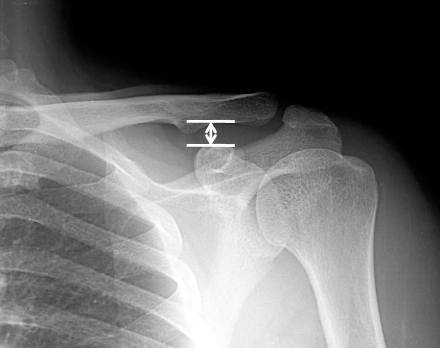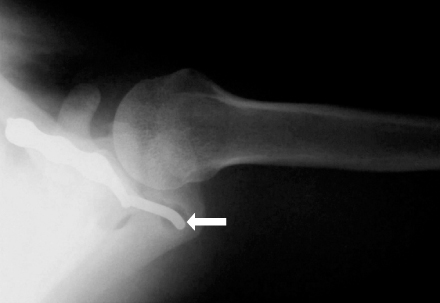J Korean Fract Soc.
2009 Oct;22(4):259-263. 10.12671/jkfs.2009.22.4.259.
Long Term Follow up Results of the Operative Treatment of the Acromioclavicular Joint Dislocation with a Wolter Plate
- Affiliations
-
- 1Department of Orthopedic Surgery, Yong-San Hospital, Chung-Ang University College of Medicine, Seoul, Korea. boneman@cau.ac.kr
- KMID: 1469992
- DOI: http://doi.org/10.12671/jkfs.2009.22.4.259
Abstract
- PURPOSE
To evaluate the long-term clinical and radiological results of the operative treatment of the acromioclavicular dislocation with a Wolter plate. MATERIALS AND METHODS: We reviewed clinical and radiological data of twenty patients (mean age: 37 years) who underwent the operative treatment of acromioclavicular joint dislocation using a Wolter plate from September, 1999 to December, 2002 with minimum of five years follow-up (average 6 years 7 months). The clinical outcomes of twenty patients were evaluated by UCLA scoring and radiological results of fifteen patients with available radiograph were evaluated by Zanca view and stress view. RESULTS: The mean UCLA score was mean 33 points (range, 27~35) at final follow up. By clinical evaluation, twelve cases (60%) were excellent, six cases (30%) were good and two cases were poor (10%). By radiological evaluation, eight cases (54%) were excellent (without displacement), five cases (33%) were good (displacement <5 mm) and two cases (13%) were poor (displacement >5 mm). Erosive change in acromioclavicular joint was seen in poor case. CONCLUSION: Wolter plate fixation may be a useful modality for treating acromioclavicular joint dislocation. Great care should be taken to make the hook hole at the appropriate position during operation for long-term prognosis.
Keyword
Figure
Reference
-
1. Bannister GC, Wallace WA, Stableforth PG, Huston MA. The management of acute acromioclavicular dislocation. A randomised prospective controlled trial. J Bone Joint Surg Br. 1989; 71:848–850.
Article2. Bosworth BM. Acromioclavicular dislocation; end-results of screw suspension treatment. Ann Surg. 1948; 127:98–111.3. Calve E, Lópe-Franco M, Arribas IM. Clinical and radiologic outcomes of surgical and conservative treatment of type III acromioclavicular joint injury. J Shoulder Elbow Surg. 2006; 15:300–305.
Article4. Chun JM, Kim SY, Choi JH, Kim TS, Kim KY. Surgical treatment of the acute acromioclavicular joint dislocation using a wolter plate. J Korean Orthop Assoc. 2002; 37:185–190.
Article5. Dewar FP, Barrington TW. The treatment of chronic acromioclavicular dislocation. J Bone Joint Surg Br. 1965; 47:32–35.
Article6. Ellman H, Hanker G, Bayer M. Repair of the rotator cuff. End-result study of factors influencing reconstruction. J Bone Joint Surg Am. 1986; 68:1136–1144.
Article7. Gstettner C, Tauber M, Hitzl W, Resch H. Rockwood type III acromioclavicular dislocation: Surgical versus conservative treatment. J Shoulder Elbow Surg. 2008; 17:220–225.
Article8. Guy DK, Wirth MA, Griffin JL, Rockwood CA Jr. Reconstruction of chronic and complete dislocation of the acromioclavicular joint. Clin Orthop Relat Res. 1998; 347:138–149.9. Habernek H, Weinstabl R, Schmid L, Fialka C. A crook plate for treatment of acromioclavicular joint separation: indication, technique, and results after one year. J Trauma. 1993; 35:893–901.10. Hessmann M, Gotzen L, Gehling H. Acromioclavicular reconstruction augmented with polydioxanonsulphate bands. Surgical technique and results. Am J Sports Med. 1995; 23:552–556.
Article11. Inman VT, Saunders JB, Abott LC. Observation on the function of the shoulder joint 1944. Clin Orthop Relat Res. 1996; 330:3–12.12. Kennedy JC, Cameron H. Complete dislocation of the acromioclaviclar joint. J Bone Joint Surg Br. 1954; 36:202–208.13. Larsen E, Hede A. Treatment of acute acromioclavicular dislocation. Three different methods of treatment prospectively studied. Acta Orthop Belg. 1987; 53:480–484.14. Lee HJ, Lee EW, Kang KS, et al. Operative treatment of complete dislocation of the acromioclavicular joint with a wolter plate. J Korean Orthop Assoc. 2002; 37:459–463.
Article15. Lin B, Lian KJ, Guo LX, et al. Comparative study on treating complete dislocation of acromioclavicular joint with three different methods. Chin J Traumatol. 2004; 7:101–107.16. MacDonald PB, Alexander MJ, Frejuk J, Johnson GE. Comprehensive functionctional analysis of shoulders following complete acromioclavicular separation. Am J Sports Med. 1988; 16:475–480.
Article17. Morrison DS, Lemos MJ. Acromioclavicular separation. Reconstruction using synthetic loop augmentation. Am J Sports Med. 1995; 23:105–110.18. Phemister DB. The treatment of dislocation of the acromioclavicular joint by open reduction and threaded-wire fixation. J Bone Joint Surg. 1942; 24:166–169.19. Rockwood CA, Matsen FA. Disorders of the acromioclavicular joint. The shoulder. 2nd ed. Philadelphia: WE Saunders Co;1998. p. 483–543.20. Sim E, Schwarz N, Höcker K, Berzlanovich A. Repair of complete acromioclavicular separations using the acromioclavicular-hook plate. Clin Orthop Relat Res. 1995; 314:134–142.
Article21. Taft TN, Wilson FC, Oglesby JW. Dislocation of the acromioclavicular joint. An end-result study. J Bone Joint Surg Am. 1987; 69:1045–1051.
Article22. Weaver JK, Dunn HK. Treatment of acromioclavicular injuries, especially complete acromioclavicular separation. J Bone Joint Surg Am. 1972; 54:1187–1194.
Article
- Full Text Links
- Actions
-
Cited
- CITED
-
- Close
- Share
- Similar articles
-
- Operative Treatment of Complete Dislocation of the Acromioclaviclar Joint with a Wolter Plate
- Surgical Treatment of the Acute Acromioclavicular Joint Dislocation Using a Wolter Plate
- The Treatment of Acromioclavicular Dislocation Comparison Study between Bosworth Screw and Wolter Plate Technique
- Clinical Comparison of Two Types of Hook Plate in Surgical Treatment of Acromioclavicular Dislocation: AO Hook Plate and Wolter Plate
- Result of Wolter Plate Fixation for the Treatment of Dislocation of Acromioclavicular Joint and Clinical Importance of Coracoclavicular Ligament Repair




